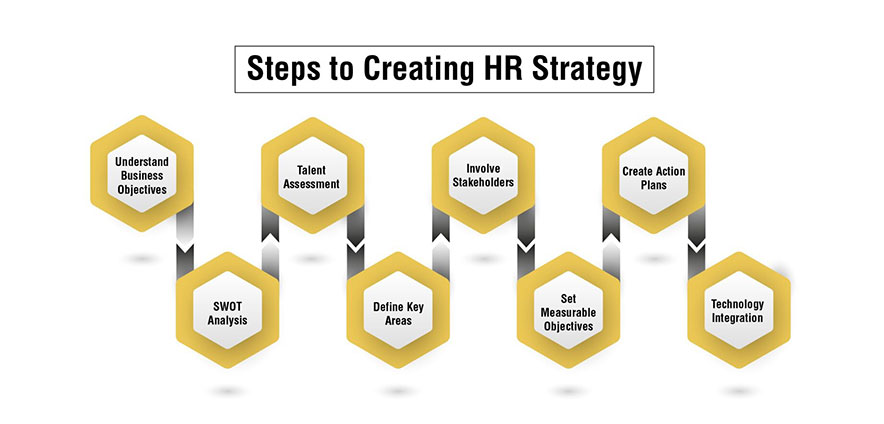Building an effective HR strategy for Organizational Excellence

Human Resources strategy acts as the compass that guides organizations. The strategy helps with talent management, employee engagement, and organizational success. HR professionals can steer their organizations toward sustained growth and excellence through successful strategies.
The art lies not just in formulating its strategy but in the execution. This keeps up with the ever-evolving needs of the organization. Let us delve into the core of HR strategy to unravel its components. Keep reading to see how the execution of HR strategies takes place.
What is HR strategy?
The HR strategy is a comprehensive plan that aligns human initiative with an organization's goals. It encircles areas such as talent acquisition, training and development and performance management. Also, it focuses on fostering a positive workplace culture. The goal is to optimize the workforce to meet current and future business needs. This contributes to the overall success of the organization.
Why is HR strategy important?
An HR strategy is the backbone of organizational success. It plays a crucial role in navigating the complex landscape of human resources management. Moreover, its importance lies in its ability to align workforce initiatives with overarching business objectives.
Strategically addressing talent acquisition, development, and retention is vital. This ensures that the organization's human capital is tuned to meet evolving demands. It fosters a proactive approach to challenges. From skill gaps to industry shifts, it assures that the workforce remains agile and adaptable.
Moreover, a well-crafted HR strategy contributes to a positive workplace culture. It promotes employee engagement and satisfaction. Also, it serves as a guiding light that drives the organization toward optimal performance. It promises resilience and sustained growth in the ever-changing landscape of the business world.
How to create HR strategy
Creating an effective HR strategy involves a thoughtful and strategic approach. Here is a step-by-step guide:

-
Understand Business Objectives
Aligning HR strategy with the organization's mission, vision, and strategic goals is the first step. It is crucial to identify key areas where the workforce can contribute to business objectives.
-
SWOT Analysis
Next, conduct a SWOT analysis to assess Strengths, Weaknesses, and Opportunities. Also, identify the threats related to the current workforce and HR practices. Use insights to inform strategy development.
-
Talent Assessment
Evaluate the current skill set and capabilities of the workforce. Identify gaps and future needs to shape recruitment and training.
-
Define Key Areas
Clearly define key focus areas from the beginning. Talent acquisition, employee development, performance management, and workplace culture are some critical areas to focus on.
-
Involve Stakeholders
Collaborate with key stakeholders, including leadership and employees. Make sure to gather input and insights from them. See to it that the HR strategy reflects the perspectives of various departments. Also, it should include levels within the organization.
-
Set Measurable Objectives
Establish clear, measurable objectives for each aspect of the HR strategy. Define key performance indicators to track progress and success.
-
Create Action Plans
Develop detailed action plans for each objective. Outline specific steps, timelines, and responsible parties. Ensure that the plans are realistic and achievable.
-
Technology Integration
Leverage HR technology to streamline processes. Also, it helps to enhance analytics and support data-driven decision-making. Most importantly, select tools that align with the organization's goals to improve its efficiency.
Best practices for implementing HR strategy
Implementing an HR strategy effectively involves incorporating best practices. This is to ensure seamless execution. Here are the essential guidelines:
-
Leadership Alignment
Ensure alignment between HR strategy and organizational goals. Do this by engaging in leadership from the outset. Gain leadership commitment and support to promote a cooperative approach.
-
Clear Communication
Communicate the HR strategy transparently to all levels of the organization. Clarify expectations and benefits. This will help in fostering understanding.
-
Employee Involvement
Involve employees in the implementation process. Encourage feedback and incorporate insights to enhance the strategy's relevance.
-
Training and Development
Provide training for HR professionals and employees on new initiatives. Ensure that everyone understands their role in achieving the strategy's objectives.
-
Change Management
Implement change management strategies to navigate transitions smoothly. Address resistance by highlighting the benefits of the HR strategy.
What are some examples of HR strategy?
Here are examples that showcase the diversity of HR strategies. Each one is tailored to address specific aspects of workforce management.
-
Talent Acquisition Strategy
This strategy focuses on attracting and recruiting top talent. It can be done through targeted employer branding and innovative sourcing methods.
-
Learning and Development Strategy
This emphasizes continuous skill development for employees through training programs. Such mentorship initiatives should align with organizational goals.
-
Performance Management Strategy
Establishes a robust performance evaluation system. It primarily emphasizes regular feedback, goal setting, and professional development plans.
Final Words
Remember that the effectiveness of an HR strategy depends on its alignment with the overall goals of the organization. Also, it relies on its ability to adapt to changing circumstances.

